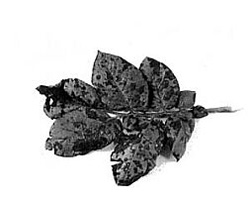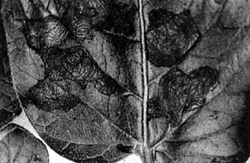Target spot (early blight) of potatoes
Target spot (or early blight) is one of the most common diseases attacking leaves and stems of potatoes. It usually spreads during autumn and is welcomed by some growers as a haulm killer. But it can cause losses if outbreaks occur early in the season, or in late maturing crops.
The disease is caused by the fungus Alternaria solani. The same organism attacks tomatoes, capsicums and related plants.
Symptoms of target spot
The following symptoms can indicate target spot.
On leaves:
- The disease starts as small circular to oval dark brown to black spots on leaves.
- These spots enlarge, becoming oval to angular, and are normally confined within the main veins of the leaflets. They're usually up to 6 mm in diameter, but under favourable conditions individual spots can grow to 10 mm to 12 mm (Figure 1).
- They develop a leathery appearance.
- The development of close concentric rings within each spot gives the disease its name, target spot (Figure 2).
- When the disease is severe, spots can unite and cause an upward rolling of the leaf tips and death of leaves.

On stems:
- Spots that develop on stems are more elongated than those on the leaves.
On tubers:
- Target spot can sometimes infect the tubers.
- It appears as small dark, slightly sunken, circular to irregular-shaped lesions (10 mm to 20 mm in diameter), with slightly raised margins.
- A brownish, corky dry rot up to 6 mm deep develops in the tissue beneath the lesion.
- Affected tubers are prone to attack from other soil fungi, which can cause complete rotting of the tuber.
Controlling target spot
Effective control of target spot involves a combination of measures:
- practise crop rotation to help reduce initial levels of the disease
- plant healthy seed to avoid infecting a clean paddock
- keep plants growing vigorously – plants with adequate nutrition and water that are free from other diseases are less prone to infection
- apply registered fungicides
- burn dead haulms – when infection is bad, burning trash after harvest will reduce carry over to the next season.
Spread of disease
When spores are produced in spring, they're spread by:
- wind
- rain
- insects.
Spores fall on potato leaves and remain on the surface until conditions are favourable. They then germinate and penetrate the plant, causing an outbreak of disease.
The disease attacks plants that lack vigour. It often spreads towards the end of the season when the plants have stopped growing.
Target spot often kills the tops of the plants. When defoliation is premature, this means lower yields of tubers.
Environmental conditions
Target spot develops best in high temperatures and high humidity.
Survival of the fungus
The fungus causing target spot symptoms is carried over between seasons on plant refuse in the soil. This carryover can lead to widespread infection that generally occurs in crops before harvest.
Reporting an unusual plant insect pest or disease
Report any unusual plant pest or disease immediately using our online reporting form or by calling the Exotic Plant Pest Hotline on 1800 084 881. Early reporting increases the chance of effective control and eradication.
Please take multiple good quality photos of the pests or damage to include in your report where possible, as this is essential for rapid pest and disease diagnosis and response.
Your report will be responded to by an experienced staff member, who may seek more information about the detection and explain next steps.
Report onlinePhoto credits
Figure 1 Courtesy of Howard F. Schwartz, Center for Invasive Species and Ecosystem Health. Colorado. State University.
Figure 2 Courtesy of Howard F. Schwartz, Center for Invasive Species and Ecosystem Health. Colorado State University.